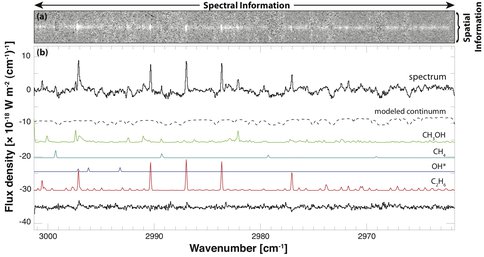2011 Annual Science Report
 NASA Goddard Space Flight Center
Reporting | SEP 2010 – AUG 2011
NASA Goddard Space Flight Center
Reporting | SEP 2010 – AUG 2011
High-Resolution Spectroscopy of Comets at Infrared Wavelengths
Project Summary
Dr. Lucas Paganini has initiated a robust means for quantitative detections of sulfur compounds at submillimeter and infrared (IR). He was awarded 20 hours observing time with the ESO’s sub-millimeter and far-IR Herschel Space Observatory for a proposed investigation on the analysis of OPR and D/H of hydrogen sulfide in comets. And he collaborated extensively on astronomical observations and scientific interpretation of comets 103P/Hartley 2, C/2003 K4 (LINEAR), and 10P/Tempel 2.
Project Progress
During this period, NASA Postdoctoral Fellow Dr. Lucas Paganini has initiated a robust means for quantitative detections of sulfur compounds at submillimeter and infrared (IR) wavelengths by means of quantum fluorescence models. These achievements will enable new measurements of the content of hydrogen sulfide in comets. Studies of cometary diversity can be extended significantly by measuring H2S simultaneously with other parent volatiles (organics, nitriles, and water). This will ultimately enhance our knowledge about the dynamical distribution and evolution of cometary volatiles in the Solar System, and provide further insights on their relation with interstellar ices and/or the protosolar nebula at the time when comets formed.
To this end, NASA scientists Dr. Lucas Paganini (NPP Fellow, PI), Dr. Michael Mumma and Dr. Geronimo Villanueva (Co-I’s); and Dr. Alexandre Faure (Collaborator), Laboratoire d’Astrophysique de Grenoble; were awarded 20 hours observing time with the ESO’s sub-millimeter and far-IR Herschel Space Observatory for their proposed investigation “Analysis of OPR and D/H of hydrogen sulfide in comets: Testing the natal origin and constraining the place of formation of pre-cometary ices in the protoplanetary disk.” (This achievement represents 1 out of 14 proposals around the world awarded (OT1) observation time for Solar System exploration objects with the Herschel Observatory.) This investigation will target cosmogonic parameters in bright comets during the 2011–2012 observation period, through measurements of the nuclear spin temperature in H2S (via the ortho-para ratio, or OPR) and enrichment of its deuterated isotopologue (HDS). These parameters will constrain the temperature of formation of sulfur species, and will test the role of various processes in their production (e.g., ion-molecule, neutral-neutral gas reactions, and gas-grain heterogeneous chemistry). In addition, simultaneous observation of a water emission line will aid the retrieval of accurate abundances H2S/H2O and HDS/H2O.
In addition to his work on the determination of sulfur content in comets, Dr. Paganini has worked on and improved current analysis tools and pipelines for data processing of infrared observations by our group. He has also collaborated extensively on astronomical observations and presentation in scientific conferences of comet 103P/Hartley 2, the target of NASA’s EPOXI Mission to understand the wide diversity of morphology and topography of cometary nuclei; comet 10P/Tempel 2, and comet C2003/K4 (LINEAR). This collaboration has resulted in two ApJ papers (Mumma et al., 2011; and Meech et al., 2011), and a third publication submitted to Icarus (Paganini et al., 2011).
Figure 1. Spatial profiles of primary volatiles and continuum in comet 10P/Tempel 2. These profiles reveal significant outflow of major volatiles at a P.A. = 20°, which was coincident with a jet-like feature observed by optical observers in 2010 mid-July. We aligned the slit along the jet, which is placed horizontally in this plot. The ends of the slit (+, -) indicate the direction of pixels displayed on the abscissa and the grey shaded region is a representation of the PSF. Source: Paganini et al., 2011 (submitted).
Figure 2. Astronomical observations of comet C/2003 K4 (LINEAR) unveiled the presence of minor volatiles on UT 2004 Nov 28. Panel (a) an Echellogram providing spectral and spatial information of these volatiles. (b) Order 23 (KL1) shows ethane (C2H6) Q-branches along with CH3OH, CH4, and OH*. Here, the dashed line represents a model of the cometary continuum and the scaled atmospheric transmittance function.
Publications
-
Meech, K. J., A’Hearn, M. F., Adams, J. A., Bacci, P., Bai, J., Barrera, L., … Ziffer, J. E. (2011). EPOXI : COMET 103P/HARTLEY 2 OBSERVATIONS FROM A WORLDWIDE CAMPAIGN. The Astrophysical Journal, 734(1), L1. doi:10.1088/2041-8205/734/1/l1
-
Mumma, M. J., Bonev, B. P., Villanueva, G. L., Paganini, L., DiSanti, M. A., Gibb, E. L., … Magee-Sauer, K. (2011). TEMPORAL AND SPATIAL ASPECTS OF GAS RELEASE DURING THE 2010 APPARITION OF COMET 103P/HARTLEY 2. The Astrophysical Journal, 734(1), L7. doi:10.1088/2041-8205/734/1/l7
-
PROJECT INVESTIGATORS:
-
RELATED OBJECTIVES:
Objective 1.1
Formation and evolution of habitable planets.
Objective 3.1
Sources of prebiotic materials and catalysts
Objective 3.2
Origins and evolution of functional biomolecules


